
|
Two graduate students got master's degrees related to the development of the instruments of the TAO telescope!
Two graduate students of the Department of Astronomy, the University of Tokyo, Masahito Uchiyama and Yutaka Kobayakawa, successfully obtained master degrees. They were working as major team members of the 1st generation instruments for the TAO 6.5 m telescope "Near-infrared multi-object spectroscopic camera SWIMS" and "Mid-infrared camera/spectrograph MIMIZUKU". In the following, we introduce the research achievements filled with their two years of elaborate efforts.
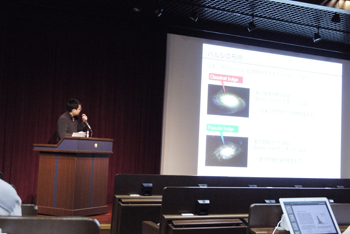
Master thesis presentation at Koshiba Hall on February 4, 2016.
Development of simultaneous two-field observation method for mid-infrared high-precision monitoring
Department of Astronomy, Graduate School of science,
The University of Tokyo
UCHIYAMA, Masahito
|
In our laboratory, we are developing MIMIZUKU, a mid-infrared camera/spectrograph for the 6.5 m TAO telescope. Mid-infrared light is radiated from a relatively low temperature region (50-500 K) in the universe and is suitable for observing state of solid particles, "dust", present around stars. My goal is to understand in detail how a planet is formed through accumulation and collision of the dust, by observing how the dust modifies.
In order to achieve this goal, it is necessary to conduct "mid-infrared high precision monitoring" which observes light curves of objects in detail over a long period of time. However, infrared satellites capable of high-precision observation has short life-time and their observing time is limited, so such an observation is difficult. Also, since observation by ground-based telescopes is influenced by fluctuation of atmospheric transmittance and photometric accuracy is bad (empirically has ~10% photometric error), only significant temporal variation could have been discussed. To solve this problem, we have newly developed a two-view synthesis mechanism called "Field Stacker".
Field Stacker is a movable optical system mounted on top of MIMIZUKU, operated under room temperature. By adjusting two pickup mirrors using three movable stages of tilt, linear motion and rotation, it picks out arbitrary two objects from φ25 arcmin field of view of the TAO telescope and image them on a single detector. Thus, a target and a reference star is observed simultaneously and real-time flux calibration can be carried out: This will enables us to correct for the fluctuation of the atmospheric transmittance, and realize high-accuracy monitoring in the mid-infrared wavelength even from the ground.
In the master thesis, I demonstrated feasibility of the Field Stacker from following two measurements and analyzes whether the expected high precision can be realized by the simultaneous observation. First, angular accuracy of the pickup mirror is extremely important for achieving the high precision observation. We calculated amount of acceptable angular error of the pickup mirror and measured and estimate the angular error occurring at various places using the real Field Stacker. As a result, I have shown that photometric accuracy of 1-2% can be achieved. Secondly, in the observation using the Field Stacker, it is necessary to take into account the spatial difference of the atmospheric transmittance within the field of view of 25 arcmin, which is about 10 times larger than that of the existing instruments (1 to 2 angles).
We have analyzed past observation data of the mid-infrared background light which traces the atmospheric transmittance, and acquired the time fluctuation information, and converted it into spatial structure of the transmittance assuming the structure of the upper atmosphere. As a result, we found that the difference is sufficiently small for achieving photometric accuracy of 1 to 2%, and will not be a large problem.
There is no device with a concept like Field Stacker so far, and it will be realized for the first time in the world by MIMIZUKU. As no prior research existed, the most difficult and challenging part of my study is to think about a method to show the feasibility of this system. I will continue developing the Field Stacker in the PhD course. MIMIZUKU is now preparing for the test observation planned in 2016, and I am very much looking forward to carrying out observations using the Field Stacker.
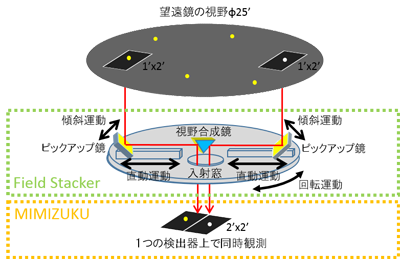
Concept of the Field Stacker
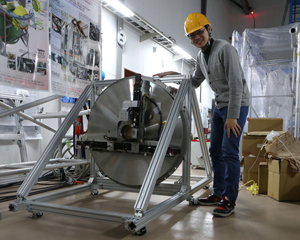
Field Stacker on a handling cart and the author
|
Observational study of dust attenuation in nearby luminous infrared galaxies using hydrogen emission lines
Department of Astronomy, Graduate School of science,
The University of Tokyo
KOBAYAKAWA, Yutaka
|
The bulge of a spiral galaxy has been thought to have a structure similar to an elliptical galaxy, consists of stars that orbit randomly (Classical bulges). However, in recent years many bulges are found to rotate like galaxy disks(Pseudo bulges). Theoretical studies using numerical simulation predict various formation mechanisms for these different bulges, but there are not many observational studies yet. We are studying relation between star formation activities and bulge formation, focusing on LIRGs (Luminous Infrared Galaxies). However, since LIRGs are covered with a large amount of dust generated by their active star formation activities, it is difficult to see the internal star formation activity with visible light. So, we used the near infrared camera ANIR mounted on the miniTAO 1 m telescope to observe the hydrogen Paα emission line (Paschen alpha emission line, at wavelength of 1.285µm), which is less affected by dust attenuation, and studied the star formation activity of LIRGs. In previous studies using the Paα, it is known that spatial distribution of the star formation region in LIRGs correlates with bulge structure.
However, even with the Paα emission line, the influence of dust extinction is not negligible, and a maximum extinction of about 1 magnitude is expected even at the wavelength of Paα. In the results mentioned above, the influence of dust attenuation was not taken into account, and it was necessary to evaluate the dust extinction to show whether there really is a relationship between bulge structure and star formation activity. By using the property that the light with longer the wavelength is less affected by dust extinction, the amount of attenuation can be obtained by measuring intensity ratio of two emission lines and comparing it with the intrinsic ratio. Therefore, in this study, we newly analyzed the images of hydrogen Hα emission line taken by Hawaii University 88-inch telescope / WFGS2 and Paβ emission line by miniTAO / ANIR in addition to the Paα emission line, and obtained amount of extinction from the intensity ratios of the emission lines. For the 7 LIRGs, we found that the attenuation in the central part tends to be larger, compared to that of the whole galaxy. However, at the Paα emission line wavelength, the difference of the extinction is as small as 0.3 magnitude, and its influence on the evaluation of the spatial distribution of the star formation activity is expected to be small. Thus, the Paα emission line is an optimal tool to probe the star formation activity of LIRGs, and our study demonstrates the strength of the miniTAO telescope / ANIR as one of the few instruments that can observe it.
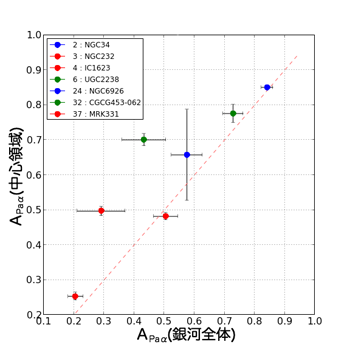
Comparison of total (horizontal axis) and central (vertical axis) extinction of seven nearby LIRGs. Although extinction at the central region tends to be large, the difference is small at the wavelength of Paα emission line (maximum 0.3 magnitude)
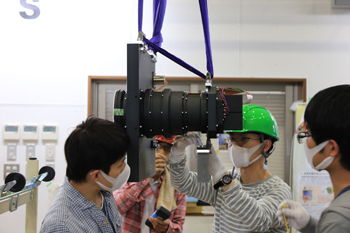
The author participating in SWIMS development work (second person from the right)
|
|





